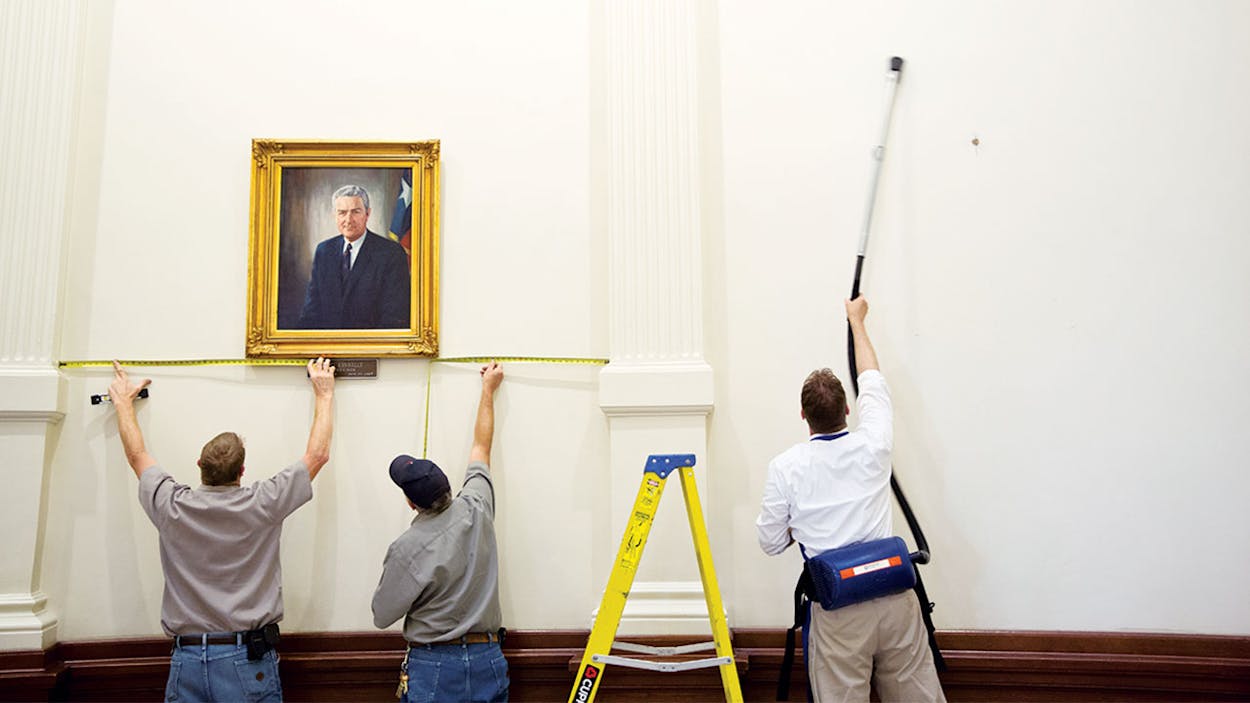Rick Perry was by far the longest-serving governor in Texas history. But at the state capitol he is memorialized in the same manner as every one of his predecessors: with an official portrait, which on May 6 was placed on a wall by the southern entrance of the rotunda. To the left of Perry’s portrait hangs that of George W. Bush, and to Bush’s left is Ann Richards, and so on, back through the decades.
But what appears to be an orderly transition of portraiture entails a lot of sweat and labor. The Texas State Preservation Board, which maintains the Capitol’s artifacts, had to take down the portraits of Perry’s 51 predecessors one by one, inspect them for wear and damage, and shift each a place to the left. It was a meticulous process that took the better part of three days.
On the Tuesday before the unveiling of Perry’s portrait, a collection of curators and workmen, cordoned off by a velvet rope, set up a long table on which to conduct inspections. Leading the check was Richard Eisenhour, the collections coordinator for the Preservation Board. He started work in 2000, he said, shortly before the last rotation of portraits. He didn’t expect so much time to pass before the next.
Sharply dressed in an apron and New Balance sneakers and holding a vacuum and a brush, Eisenhour carefully inspected each portrait at the table, removing dust and observing the lay of the paint, documenting idiosyncrasies with a camera. The portraits had never gone so many years without an in-depth review, but so far the issues had been minor. Many of the frames, for instance, vary slightly, and the rotation of the portraits leads the staff to “discover things that aren’t always symmetrical,” said Chris Currens, director of special projects at the Preservation Board. If a hook has been installed in a wall in a slightly flawed manner, that skewed setup is passed down to the portrait’s successor, just as the problems of state were inherited, in turn, by each of the portraits’ subjects. On Tuesday, one workman observed that the hook that for fifteen years held Fletcher Stockdale, the last Confederate governor of Texas, and will now host Andrew Hamilton, the first provisional governor, was an inch and a half off center. They let it be.
The collection memorializes democratic succession, but it’s also a fine guide to changing tastes in portraiture. For more than a century the statesmen—and Ma Ferguson—were generally painted in a traditional style on a solid-color background. Things changed with Beauford Jester, who served from 1947 to 1949 and elected to be captured at his desk, in mid-thought. His successor, Allan Shivers, chose to hold a book (the title is obscured). Two decades later, Dolph Briscoe looks up at us, perhaps startled, as he’s about to make a notation on a document. Bush, a man of action, sits erect on the edge of his desk, as if preparing to address a crisis, or perhaps show his portraitist the door.
Perry’s portrait, unveiled three days later, is even more dynamic: he stands behind a chair, proudly displaying his Texas A&M class ring. The question on everyone’s mind at the Capitol—will Perry be immortalized with his glasses or without?—was resolved. Future generations perusing the rotunda will find the governor barefaced.









